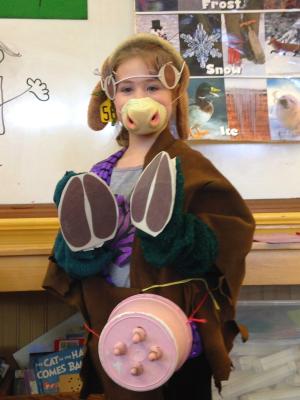Dairy in the Classroom
"Can we make cheese again today, Miss Dana?"
"Did Farmer Rosina get my card I made her?"
"Do you know my mom didn’t know how many teats were on a cow?"
These questions pummeled me as I entered a first grade classroom at Thatcher Brook Primary School in Waterbury, VT. It was my fourth visit to this class in 5 weeks, and these students had become true dairy investigators.
Since September, 24 classes in Vermont have had five visits from a dairy educator and at least one farm field trip, as part of the Dairy in the Classroom project organized by the New England Dairy and Food Council.
Shelburne Farms is providing education services for the project, tapping its expertise in farm to school education. I get to return to my roots teaching about food, farming, and nutrition; the Farm reaches a broader audience.
I worked with ten classrooms: 200 students in grades 1-4. Kids learned about the farmers in their community, the importance of farms to their everyday lives, the anatomy of a dairy cow, and how milk from cows, goats, and sheep is turned into many foods they enjoy. We taste tested and prepared dairy foods in every class: butter, cheese, ice cream, “green eggs” (scrambled eggs with cheese, butter, milk, and kale).
One second grader, “Charlie,” was described to me as a boy with food anxieties who might start crying when eating new foods. Though I usually encourage a “no-thank-you bite” from students (I never demand it), I surely didn’t want to make Charlie cry!
On my first visit to his class, Charlie sniffed the cheese, nibbled it, then promptly dropped it in the trash. At my second visit, he happily shook the butter jar and sang the butter song, but wouldn't taste the fresh butter.
On the third visit, he gave me a shy high five in the hall before class. We were making green eggs that day, to include an item from each of the three farms we had visited the previous week: a dairy farm, a farm with chickens, and one that grew kale.
I asked Charlie how he'd like to help. He chose to chop kale. After we scrambled all the ingredients together on a large plug-in skillet and delicious smells filled the room, he decided to sample the dish. I was so proud of him.
I bumped into his mom in the parking lot that afternoon. I mentioned Charlie’s hard work. She sighed, "but he didn’t eat it, right?" When I said that he had, her jaw dropped and she shouted, "NO WAY!"
"You don’t know what this means," she bubbled on, "He doesn’t eat anything. He ate it? Really? What did you make, again? I am going to the store right now to get the supplies! Maybe he will want to make it for us? I don’t believe he ate it!"
Two days later, this mom chased me down to declare how wonderful their dinner had been. Charlie had helped make it -- and he'd eaten it! "This is the best thing this school has ever done, the absolute best," she said. "This was the most important thing this year to Charlie. Thank you!"
In 12 years with Shelburne Farms, I have worn many different hats, from field trip educator, to professional development provider, to regional Farm to School network coordinator. I have worked on national Farm to School legislation, organized national conferences, raised monies for large multi-state projects. But it is experiences like working with Charlie that inspire me to continue in this field, by showing me the power of farm to school to make positive change in kids' lives. Thank you, Charlie!
*******************************************************
Shelburne Farms is continuing this program in spring 2015. To find out more about Dairy in the Classroom in 2015 and 2016, contact Virginia Holiman, vholiman@hotmail.com, 802-868-2295.

